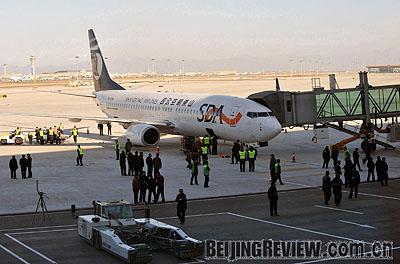| Numbers of the Week
17.5%
The total export trade agreements signed at the 104th China Import and Export Fair, also known as the Canton Fair, the country's most important trade fair, were valued at $31.55 billion, down 17.5 percent from last session.
250 billion yuan
China will start work on new airport infrastructure worth 250 billion yuan ($36.6 billion) in 2010, according to the Civil Aviation Administration of China.

TO THE POINT: Against the backdrop of the global economic downturn, the Chinese Government has loosened its monetary policy to boost national economic growth, after detecting falling inflationary pressure. It plans to initiate a value-added tax reform program on January 1 to reduce companies' tax burdens. China's property market cooled after a thriving year and grew only 1.6 percent in October year on year. The energy market also faced tremendous setbacks due to shrinking demand for power. China's trade surplus, on the other hand, reported a record-high gain in October.
By LIU YUNYUN
Major Economic Figures for October
CPI-up 4 percent
China's inflationary pressure was eased to some extent, leaving more room for interest rate cuts.
The consumer price index (CPI), a barometer of inflation, was down 0.3 percent in October compared with that of September. The National Bureau of Statistics (NBS) said the CPI's year-on-year growth in October was 4 percent, the lowest growth rate in 17 months. Pork prices, a major trigger of the yearlong inflation, dropped for the first time in almost a year by 1.2 percent year on year.
The government has made "reining in inflation" its top economic priority since the middle of last year, when citizens were hit with soaring costs of living. Afterwards, six rounds of interest rate hikes and other measures to cool the economy paid off as economic growth slowed amid the global financial turmoil.
But in the second half of the year, retaining a "relatively high economic growth rate" replaced fighting inflation as the greatest concern of decision makers. Experts reached a consensus that the central bank would come up with more rate cuts to prevent the nation's economy from being undermined by a world economic recession.
PPI-up 6.6 percent
Inflationary pressure also has eased at the wholesale level. The producer price index (PPI), a main gauge of inflation that measures goods coming out of factories, grew 6.6 percent in October year on year, down from year-on-year growth of 9.1 percent in September and a stunning 10.1 percent in August.
The prices of raw materials continued to drop, enabling manufacturers to reduce their costs. Crude oil prices rose only 11.3 percent year on year in October, down from 25.6 percent in September. Ferrous metal prices rose only 15.3 percent year on year in October, down from 24.7 percent in September.
Analysts also attributed the falling growth rate to the lag effect of government's previous monetary tightening measures. In addition, the global economic crisis dampened international demand for Chinese products, whose prices fell because of heavy inventories.
Trade surplus-$35.2 billion
China's trade surplus hit a new record high of more than $35.2 billion in October, defying the effects of the global economic downturn.
Data from the General Administration of Customs indicates that China exported a total of $128.3 billion worth of goods and imported $93.1 billion in October, an increase of 19.2 percent and 15.6 percent, respectively, year on year. Both of the growth rates declined compared with those of the previous months.
"It (the record-high trade surplus) is not a good sign," said Yao Zhizhong, a senior international trade researcher at the Chinese Academy of Social Sciences, in an interview with the International Finance News. He said the gap between imports and exports signaled insufficient domestic demand in the wake of global credit crunch. "Shrinking imports could indicate a decline in crude oil prices, and more importantly, a decline in people's income," he said.
Property prices-up 1.6 percent
The property prices in 70 large and medium-sized cities grew a mere 1.6 percent in October compared with the same month last year. It was the smallest growth rate this year, according to the NBS.
Property prices in secondary cities grew the fastest this month. For instance, property prices in Haikou, Yinchuan, Wenzhou, Jinhua, and Dandong grew 13.6 percent, 9.8 percent, 8.4 percent, 8.1 percent and 7.5 percent, respectively.
Home prices in metropolises such as Shenzhen and Guangzhou suffered the biggest drop of 15 percent and 7.4 percent, respectively, after both cities boasted the biggest home price surges in the country last year.
| 